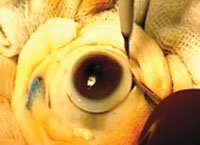Trephine makes corneoscleral excision faster, safer
Newly designed trephine can reduce decentration and increase cutting stability.
Click Here to Manage Email Alerts
One of the main difficulties encountered when performing corneoscleral button excisions from donor eyes is maintaining a well-centered and stable trephine throughout the procedure. With this problem in mind, I have designed a new trephine, which we have been using at the Eye Bank of Monza, Italy, for 3 years.
The instrument, which has been developed and produced by E. Janach (Como, Italy), consists of three separate elements: a scleral ring, a blade holder and a semidisposable round blade.
The instrument
The scleral ring has a series of small teeth on the inferior rim, which hold it firmly onto the sclera. Two small arms on opposite sides of the ring allow easy and firm grasping of the instrument with the thumb and index finger. The blade holder is a rotating cylinder on which the round blade is mounted at the beginning of the procedure. Blades are semidisposable, can perform up to 10 cuts and are available in 15- and 16-mm diameters.
The simple but useful innovation of this trephine is that the scleral ring provides perfect centration on the cornea and remains firmly in place while the cylinder, which is mounted on top of it, rotates and cuts the corneoscleral button. The blade has a special angle that allows for a sharp and precise cut with just light pressure on the bulb during the rotation maneuver. It provides a feeling of stability, safety and confidence, which makes the procedure easier and faster.
|
|
Procedure
At the beginning of the procedure the conjunctiva is lifted, and the scleral ring is centered on the cornea. The ring is held with the thumb and index finger of the left hand. Then, the blade holder and blade are inserted into the ring. After looking through the ring to confirm centration, the cylinder is rotated with the thumb and index of the right hand.
Only a minimum downward thrust of the right hand is necessary to perform the cut. The blade is sharp and the weight of the cylinder is calibrated to make it penetrate the tissue with only gentle pressure. After a few 360° turns, the blade holder can be removed, keeping the scleral ring in place. After determining that the scleral incision is deep enough, the blade holder is removed and the incision is completed with a knife, keeping it in a vertical position to cut around the trephine incision (Figure). Normally, trephination is stopped about three-quarters through the scleral thickness. If perforation occurs, stop immediately and carry on with the knife because the bulb loses tension and can no longer support the trephine.
At the Monza Eye Bank we have been using this instrument since 2001 and have prepared more than 1,500 corneoscleral buttons.
For Your Information:
- Marino Campanelli, MD, head of the Monza Eye Bank since its foundation in 1998, can be reached at Banca degli Occhi di Monza, Via Solferino 16, 20052, Monza, Italy; phone/fax: +39-039-2334731; e-mail: monzaeyebank@infinito.it.
- E. Janach srl can be reached at Via Borgo Vico, 35 - 22100 Como, Italy; +39-031-574088; fax: +39-031-572055; e-mail: mailto:international@janach.it.

